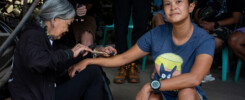Kalinga Batok:
Journeying into the Heart of the Highlands
March 23, 2024
by Tanya
18-minute read
As what has become customary for us, Sten and I came up with a vague plan of visiting the mountainous northern region of the Philippines, where rice fields and vegetable crops cover giant staircases that lead up to the skies. After completing a cursory research, we set out in our loaner A/T SUV and left the busy streets of Manila. A few missed turns later, we found ourselves cruising along the expressway. I listened to my brother’s collection of music from the unfortunate 80’s while Sten snoozed in the passenger seat.
Briefly in Baguio
We picked Baguio, the summer capital of the Philippines, as our first stop. The City of Pines in the province of Benguet is a favorite destination of lowlanders for its cool climate year-round. Unfortunately, urbanization and population growth have caused the streets to become congested and the air quality to decline over the years. We decided to stay at the edge of town and spend only one night here.
Staying in Sagada
We watched the beauty of the countryside unfold before us as we continued our journey up north. It was a comfortable drive on the paved highway, which became more curvy as we drew closer to our next stop.
Located around 1,500 meters (5,000 feet) above sea level, Sagada is known for its scenic mountain views, limestone cliffs, underground cave systems, and hanging coffins. The latter is a traditional burial technique that is still practiced by the local populace to this day. Instead of discarding their tradition when the missionaries arrived in the late 1800’s, they learned to integrate western religion into their traditional beliefs. Majority of the residents are baptized twice and possess both indigenous and Anglican names.
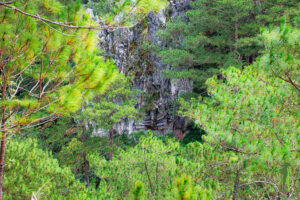
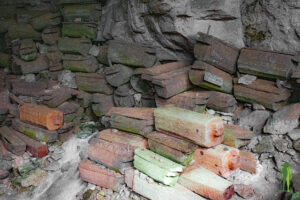

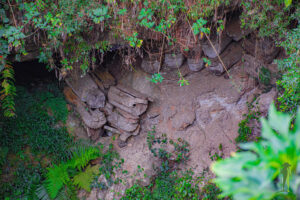
A hollowed out tree trunk houses the remains of the dead. The coffin is stored in a cave or cliffside, leaving the spirit free to roam in the afterlife. The exception are stillborn babies, who are buried in a shallow grave close to the family home.
Sagada Tourism
We like to take our time when we’re on vacation. And, since we have worked in the tourism industry for many years, we don’t like to do much on our free time either. We lazily spent our days walking on the main street, trying out local delicacies, and simply enjoying the fresh mountain air. Sten was nursing an injured knee, so we didn’t go deep into the caves, which involved not only walking down a lot of steps, but also hiking back up the same way. Needless to say, Sagada was worth the visit and we will definitely return given an opportunity.
As of this writing, it is illegal for outsiders to purchase property here, ensuring that the land stays with the local people and real estate developers are kept at bay. Local laws also stipulate that tourists must be accompanied by a certified local guide at all times.
Don’t like to read?
Click here to go straight to Kalinga Batok
A few days later, we took to the winding road again, this time with breathtaking views of the valley below keeping us company on our mountainside route. Our target was the remote village of Buscalan in Kalinga, which was the home of a traditional tattoo artist.
As I have mentioned in the beginning of this article, we only skimmed some online resources to find out about our destination. Consequently, we kept on stealing glances at the map in our navigation app to maintain our bearings. We had lost the GPS signal a long way back. We drove past some broken roads, a few narrow paths hanging over nothing, and three police checkpoints, where we had to step out of the car and register at the tourist information kiosk each time. When we were down to the last 300 meters, our automated navigator woke up to say that we had arrived.
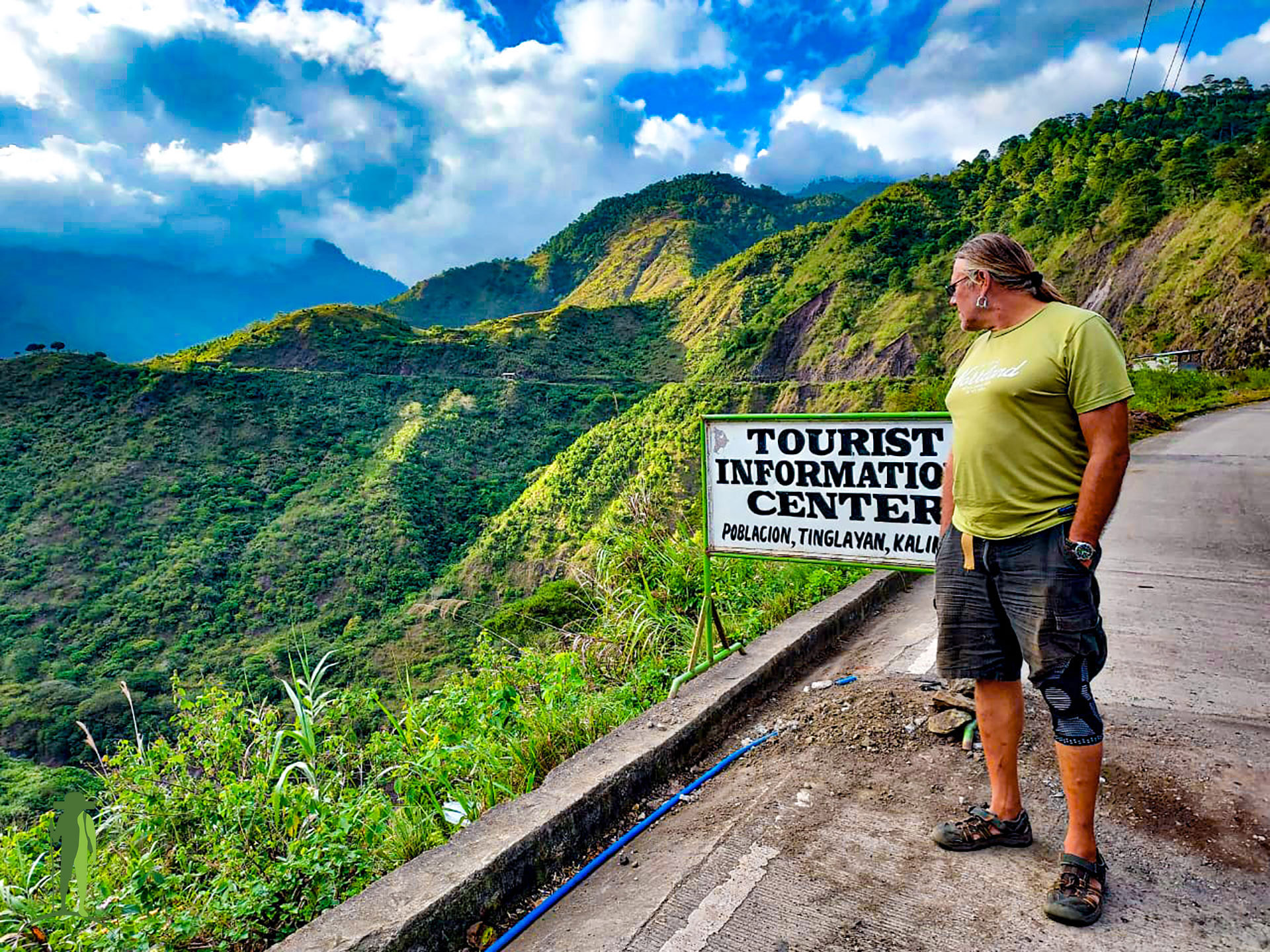
Where the Road Ends
Just where exactly we had arrived at, we racked our brains to figure out. Unless, unbeknownst to me, I booked one of the numerous porcine cribs dotting the side of the road, we didn’t see any structures that could pass off as a guesthouse. We breathed a sigh of relief when we spotted a couple of teenage boys heading our way. At least we didn’t need to turn around and drive back to the nearest village just to ask a question, “Do you know where GL’s is?”
“Oh, it’s just up ahead,” was the reply. Another sigh of relief. We didn’t lose our way, after all.
We continued on, excited to get our first glimpse of the town. A few hundred meters more and still no cluster of houses or buildings in sight. The same boys from before came upon us again. “You passed it already. You need to go back.”
They were referring to something akin to a small depot that we had just passed. Three one-story structures stood side-by-side and a line of vehicles were parked next to them. Huh? Is this it?
Don’t have time?
Click here to jump to Kalinga Batok
Someone directed us to the person manning the desk, who in turn asked us to put down our information in yet another tourist logbook. Kim, our guide, introduced herself to us and informed us that she was going to take us to our guesthouse. She pointed to an empty space where I could leave our vehicle and instructed me to drive over to the parking spot while she walked with Sten, who wanted to stretch his legs.
When we regrouped at the car, we found out from Kim that we had to walk to the guesthouse from that point on. It took us a bit of time to organize our luggage since the SUV had gradually transformed into a mini-motorhome during the drive up. After retrieving our backpacks from the car and making sure that all doors were locked, we turned to follow Kim to the edge of the world.
Too Late to Turn Back
Up until this moment, we assumed that we had already reached —or were close to reaching— the top of the mountain, where Kalinga mambabatok (tattoo practitioner) Apo Whang-od lived. (I realized after the fact that the online article that I used as reference had the writer’s thoughts arranged in such a way that could lead the reader to misunderstand some parts.)
Since we still hadn’t sighted a village, I couldn’t hold back my curiosity any longer. In response, she pointed to a cluster of buildings at the highest point of another mountain across from where we were standing. “Do you see that building with the blue roof? It’s over there.”
That’s where we’re going?!
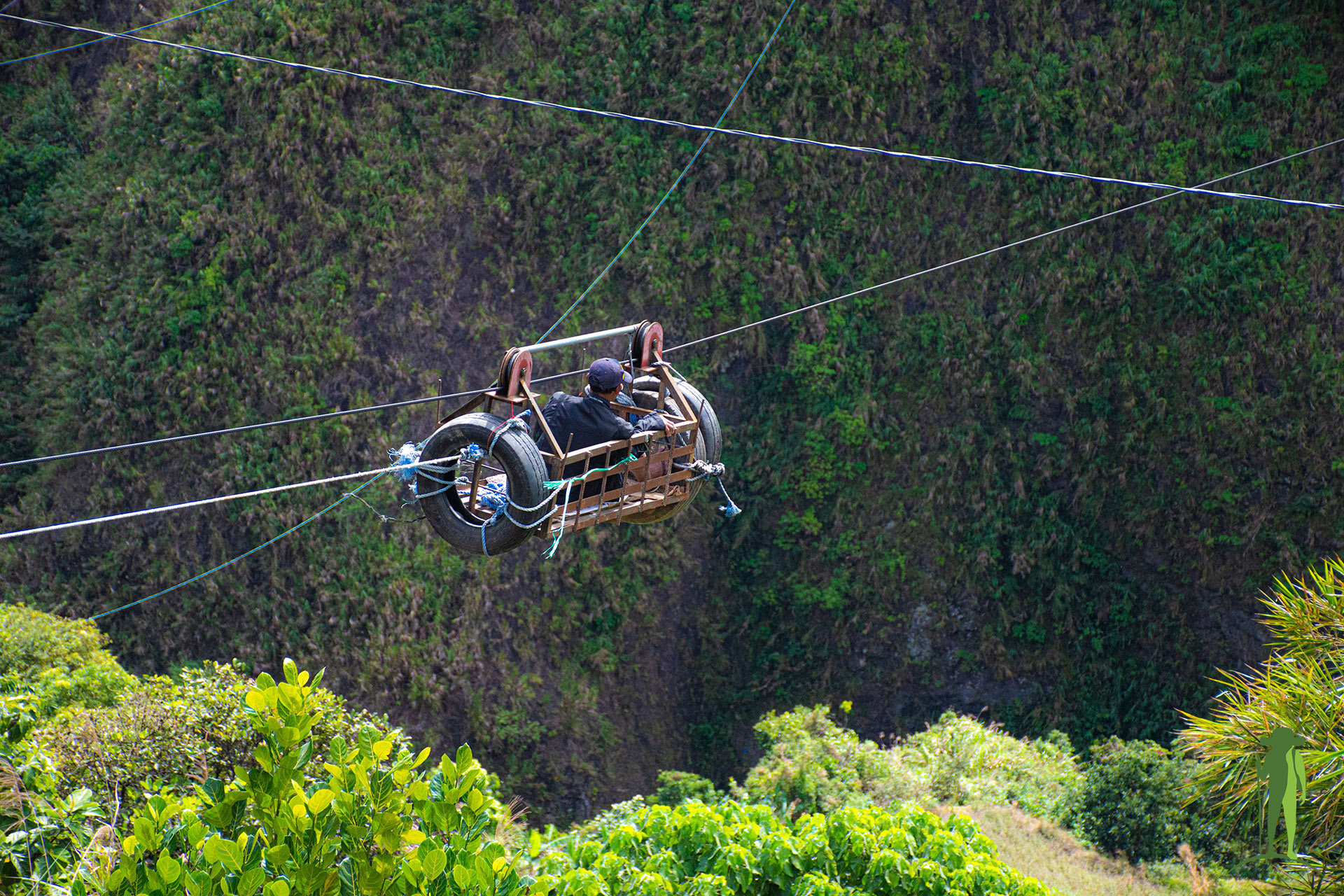
Mind Over Mountain
As it turned out, we had to hike down the steep mountainside and then climb up the other mountain to reach Apo Whang-od’s village. To say that Sten was unhappy when he heard that is an understatement. His problematic left knee was already suffering from our recent spelunking stint. This time, he needed to endure a cardio workout at altitude.
“This was a bad idea!” I heard Sten exclaim a few meters behind me. When I looked back at him, I saw that he was red in the face and sweat was slowly soaking his shirt. His aversion to heights has intensified in his “wise” age, so he was moving at a snail’s pace. Yet, he felt that he was much better off walking on solid ground instead of dangling over empty space as he crossed over to the other side on a makeshift cable car.
“This was a really bad idea!” Sten repeated for good measure. If we aborted, we would have needed to sleep in the car since we didn’t bring our camping gear. Then, we would have had to figure out the next day how the heck to get to Apo Whang-od’s place. On that thought, Sten decided to go through the nerve-wracking experience through sheer willpower. In situations like this, he prefers to tune everything out and follow his own beat. (He really dislikes having people waiting on him and cheering him on.) So, we moved ahead and waited for him to catch up to us at intervals. We made it to the other side 1.5 hours later, just before it got dark.
Don’t have patience?
Click here to skip to Kalinga Batok
The terrain eventually leveled out, and it wasn’t long before we arrived at the tourist checkpoint on this side. I took care of signing us in while Sten caught his breath. We then proceeded to make our way to our lodging house. We went through alleys and cliffside paths that had occasional gaps in the fence. Older locals whom we met along the way were not fazed by the steep drop despite their reduced agility.
“Scared of heights? This is definitely not the place to visit!” I overheard a bystander’s booming voice.
While we were navigating through the maze of houses, Kim pointed out to someone in a black hooded sweatshirt. “There’s Apo.” That’s how we saw Apo Whang-od, also known as Maria Oggay, for the first time. She was sitting on a low stool outside the door of her dwelling, handwashing some laundry. We didn’t want to intrude on her privacy, so we moved on. We figured that we would have another opportunity to meet her in the coming days.
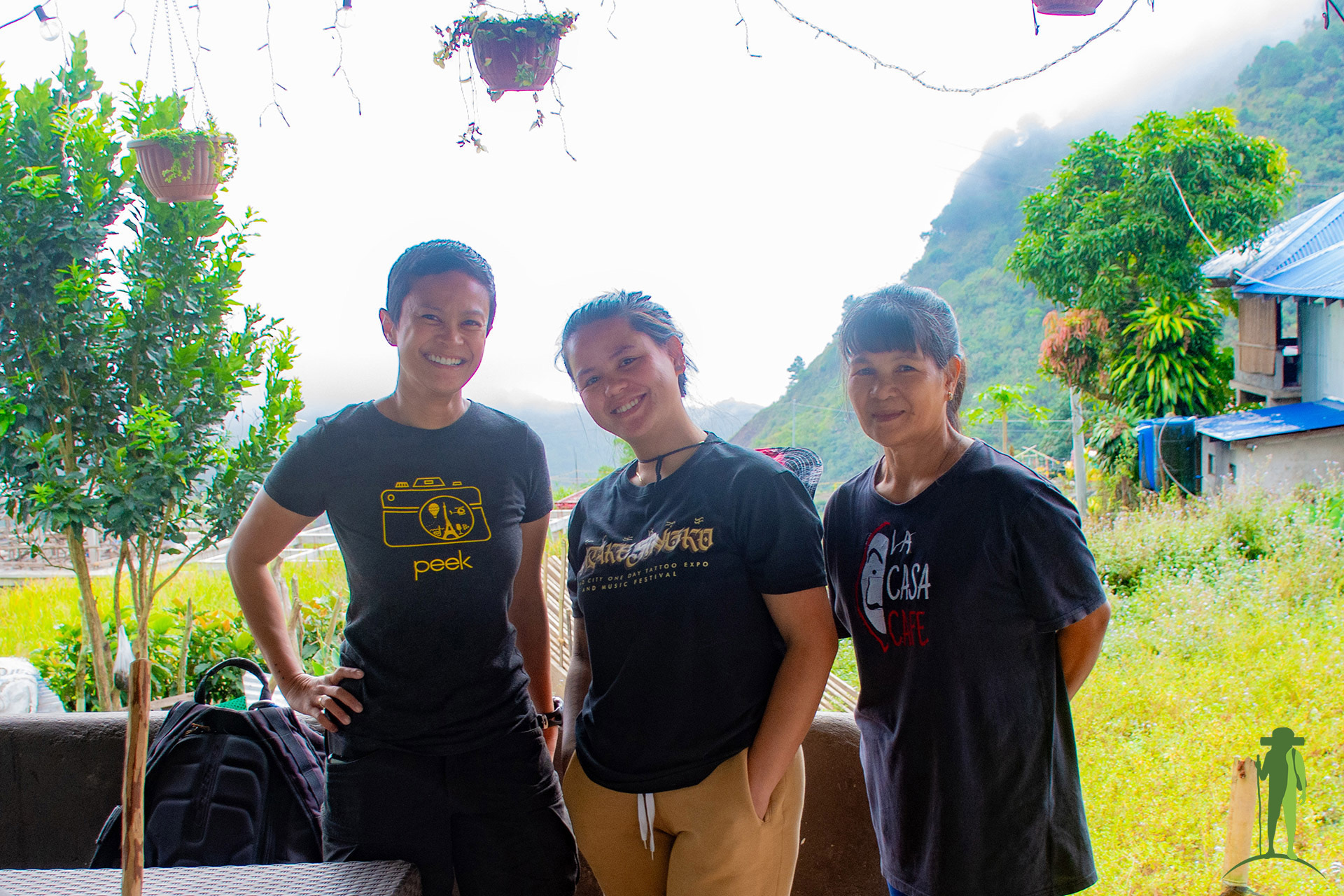
With Kim (center) and Ate Apil (right).
Tinglayan Accommodations
A few minutes later, we arrived at what was going to be our accommodations for the duration of our visit. Our guesthouse was the last one and at the highest point of the village. We waited in the shaded patio while Ate Apil, the caretaker, got our room ready.
The room assigned to us was one of three guestrooms on the upper level, which also had a communal living area, as well as a shared toilet and shower. The balcony wrapped around three sides of the building, affording an almost-360-degree lookout point. Walking down the stairs, we found the kitchen in a separate room off to the left. Across was the owner’s private living quarters, with a side entrance that led to his other guesthouse next door. A small display counter on either side and a glass door refrigerator, which served as a mini-store, completed the ground floor layout.
Finding something to eat was our next order of business. Since we came here independently, we had to source our own meals. Kim took us to a couple of sari-sari stores, where we bought a few cans of sardines, a pack of instant noodles, some chips, a roll of toilet paper. Sari-sari, which means “variety” in Tagalog, represents the type of items being sold in this neighborhood convenience store. Usually a family-run business, a sari-sari store focuses on selling dry goods at the smallest retail unit. Cold beverages and the occasional pre-cooked meats stored in a refrigerator are some of the exceptions.
After bringing us back to our homestay, Kim said goodnight and promised to return the next morning. Ate Apil had piping hot steamed rice waiting for us upstairs, so all we had to do was open up a can of sardines and dig in. Dinner was served.
Waking Up in Buscalan
We woke up to a beautiful misty morning the following day. Looking out on our balcony, we watched the clouds giving the mountaintops a good morning kiss in the distance. Kim had come by earlier, but left when she thought we were still asleep. In fact, we were awake quite early. We just decided to stay in bed and enjoy the fresh mountain air that permeated our room.
When Kim returned, she came upstairs bearing two cups of Kalinga coffee that she had prepared herself. We started our day by sipping local highland coffee amidst a natural environment with clean air and gorgeous vistas. What a luxury!
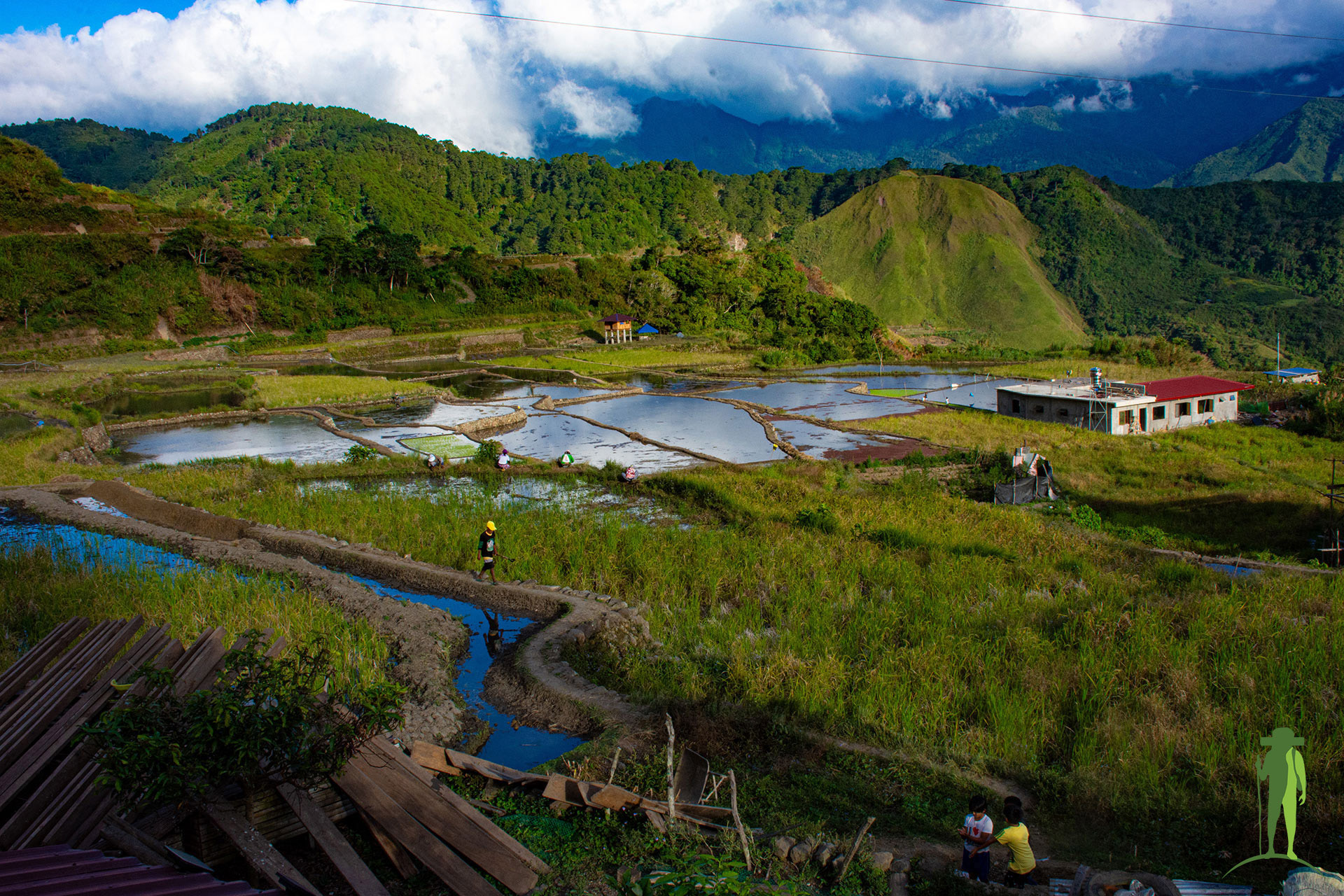
Everybody’s Doing It
How Old is Apo Whang-od, really?
Apo Whang-od was a month shy of her 107th (or 117th?) birthday at the time of our visit. (As is typical in remote villages, her exact date of birth is up for debate.) The centenarian learned the techniques of tapping from her father, who was considered a master tattooist in their region. In an interview that she gave in 2015, she recounted her beginnings as a 15-year-old apprentice from a poor household. Her first tattoos were a ladder and a python, which marked her skin purely for ornamental reasons. Parents usually tattooed their daughters to make them look prettier. Apo Whang-od was more than happy to get one since her friends already had tattoos.
As word of her talents spread, Apo Whang-od traveled farther and wider in the Cordilleras to ink headhunters. Some designs were reserved for warriors and couldn’t be tattooed on anyone else. The artist had full creative license on the design and was the one who decided where it was going to be placed. When the warrior culture declined in Kalinga, what Apo used to perform for cultural exchange transformed into an economic transaction. Tattooing for money allowed her to buy pigs and hens, slightly alleviating her from poverty.
Fifteen years ago, thatched huts sparsely dotted Apo Whang-od’s village. Back then, only adventurous domestic tourists and a smattering of foreign visitors braved a trip up to Buscalan. They were serious patrons of tattoo art who weren’t deterred by political instability, bad road conditions, and lack of accommodations. Despite tattoos being somewhat taboo at the time, Apo Whang-od was already well-known in the relatively small tattoo community. Guests who came to get a tattoo from her were welcome to stay in her home or in neighboring homestays.

Putting Kalinga Batok on the Map
One day, a tattoo anthropologist made her realize that if she died, no one else would make the tattoos anymore. The ancient art would die with her. After her boyfriend died in the conflicts following the Japanese occupation in the 1940’s, Apo vowed to remain unmarried. Having no direct descendants on her own, she started teaching Grace, her sister’s granddaughter, and Ilyang, another relative. They are considered her only real apprentices since the tradition of batok can only be taught to blood relatives. Grace and Ilyang represent two out of the three dots in Apo Whang-od’s famous signature.
Tattoo Anthropologist Dr. Lars Krutak first met Apo Whang-od in 2007, when he was doing research for his book. He lived with her for almost two weeks to talk in-depth with members of Apo’s tribal group and the Kalinga people. After his book was published, Apo Whang-od’s fame skyrocketed and she became known internationally. Tourists, foreign and domestic alike, came in busloads. Roadworks commenced. Tattoo signs and banners of Apo were hung. Concrete structures and guesthouses sprouted up. A tourist booth that doubled as a souvenir shop was inaugurated. Economy in the village took off.
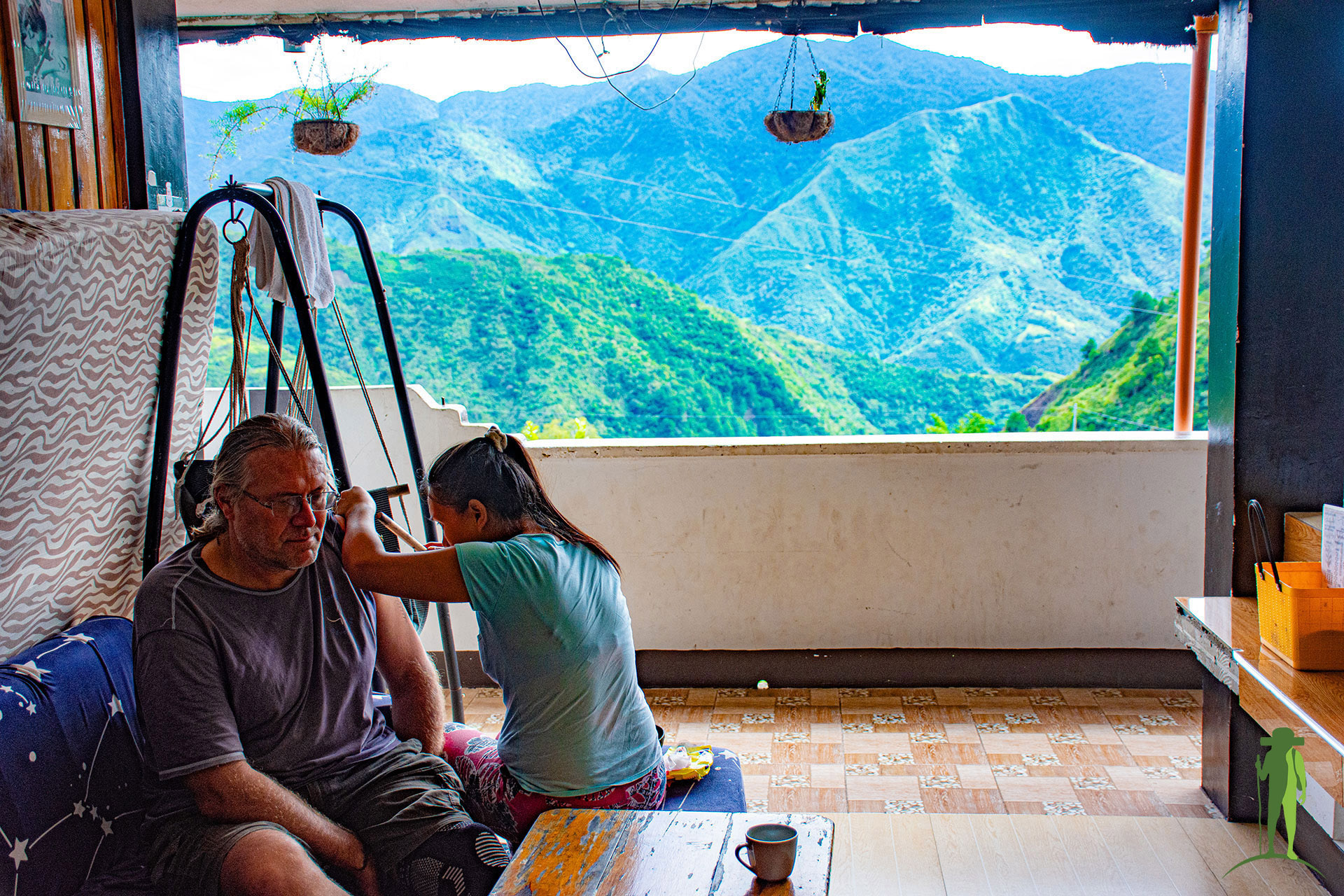
An apprentice tattooing a centipede design on Sten’s arm. First, she drafted the design using a thin, 1-inch-long guide wire. Then, with a bamboo stick and a spine of a lime plant as her implements, she tapped pasty ash into Sten’s skin for 2.5 hours.
Accidental Actors
Lars Krutak’s return to Buscalan coincided with our visit; this time, he had a film crew in tow. He arrived at the scene just when I was receiving Apo’s signature. (Sten and I had decided that one of us should get it, and that a first tattoo would be more meaningful.) My short session with Apo Whang-od was interrupted by sudden greetings, unsolicited scene blocking, and an impromptu shoot. I had unknowingly participated in a potential cameo. Belated introductions and signed releases were taken care of afterwards.
Later that evening, we were able to meet Kent Donguines, the Filipino-Canadian director of the documentary, at the only bar in the village. Kent explained his vision for the project and why this documentary was close to his heart. We also got to chat with Lars, who told us about his experiences with different tattoo cultures around the world. Once again, we were the last ones to realize that they were filming another segment. We became inadvertent listeners to an intimate bonfire dialogue between Lars and Apo Whang-od.
Since Apo only speaks Kalinga and Ilocano, Grace acted as main translator, with Kent providing supplemental commentary. While we felt that some parts were lost in translation and we wanted to chime in with questions of our own, we didn’t think it was the right time or place to do so. Nevertheless, it was a privilege to be privy to such conversation.
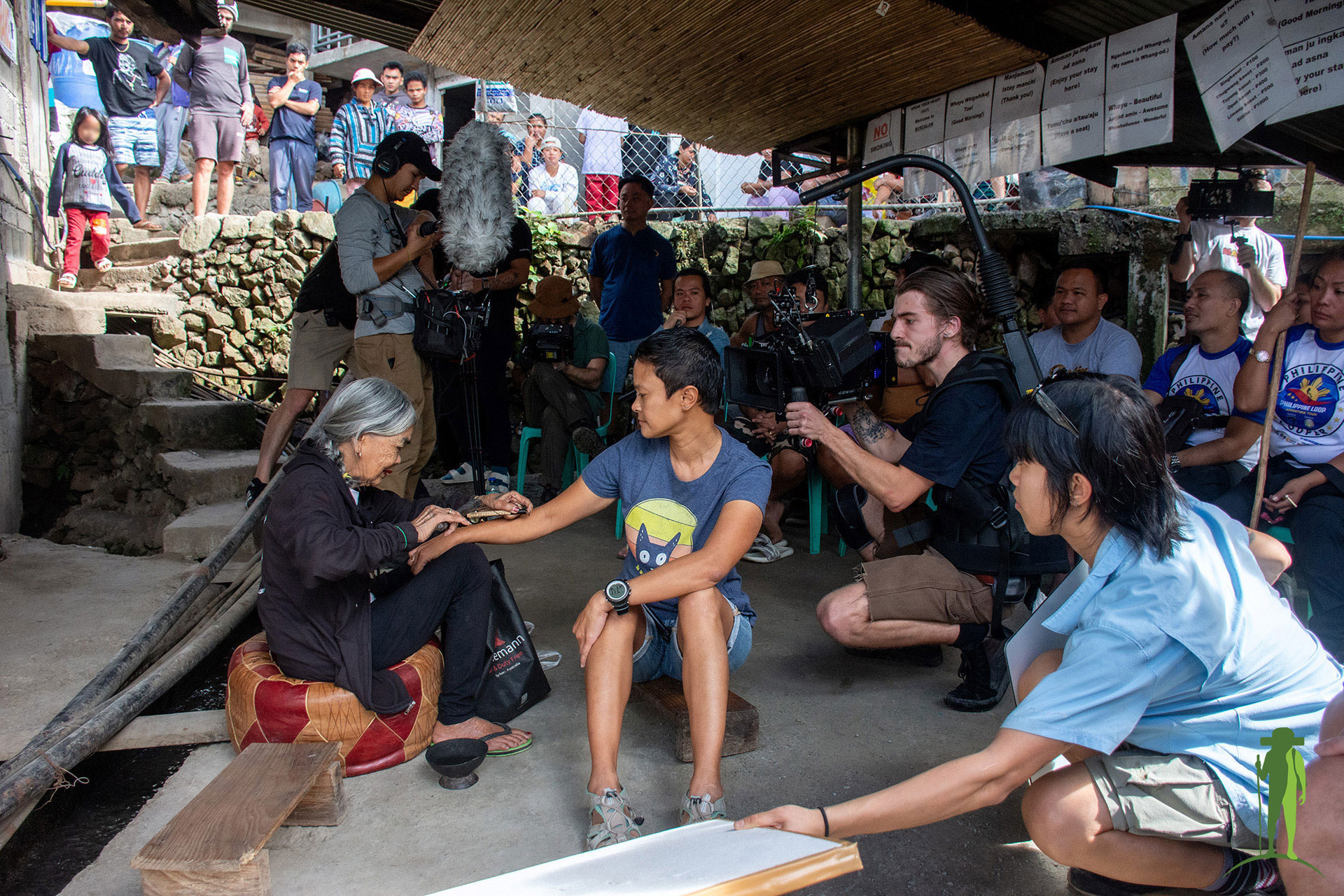
Apo Whang-od’s Legacy
“I’m grateful for the visit of people from all over the world because it gives meaning to life,” Apo Whang-od stated in one of her interviews. “I’m happy that the tradition will live on through Grace and the other apprentices,” was her answer when Lars asked her how she felt 15+ years later after their first meeting.
On the other hand, tourism leaves a culture vulnerable to exploitation from either side. Some view Kalinga batok as an opportunity to maximize one’s earnings for a minimal amount of effort. Quite a few tourists endure the long journey just so they can post their tribal tattoos on social media. Then there are individuals who take advantage of the locals’ goodwill and take one photo too many. Others simply deceive people for their own benefit, be it in terms of a service offered or a product sold.
We trekked back to the other side on the third day. This time, it only took us 35 minutes to cross over. (Kim, who took this route daily, would usually do it in 15 minutes.) We promised to try to return someday, hopefully within the next 1-3 years. We would love to meet Apo Whang-od again and see how much the village had changed.
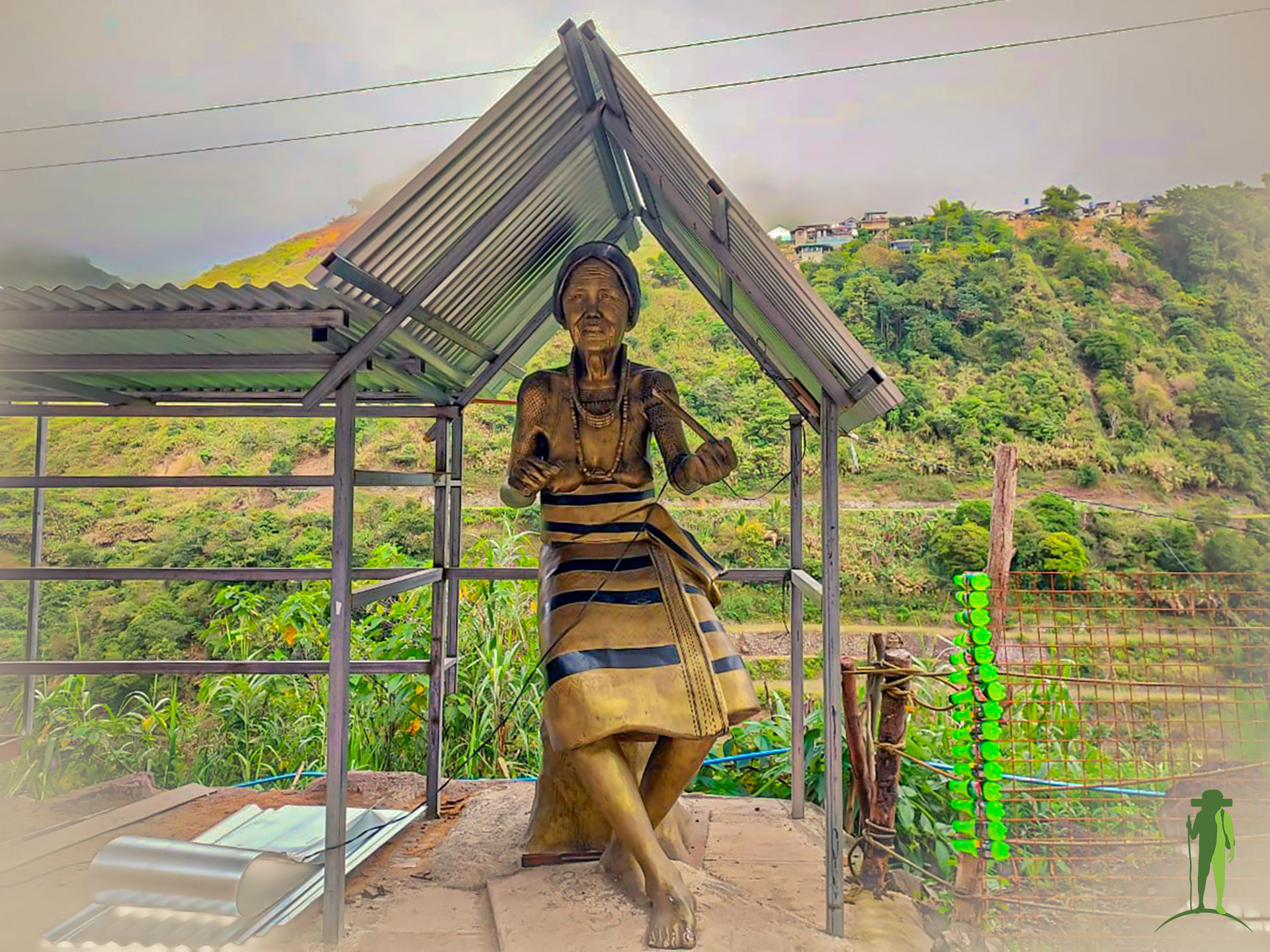
To learn more about Kent Donguines’s documentary, see https://goldenglobes.com/articles/filmmaker-kent-donguines-explores-tattooing-political-statement-treasure-rice-terraces/
To read or order Dr. Lars Krutak’s book, visit https://www.larskrutak.com/product/kalinga-tattoo-ancient-and-modern-expressions-of-the-tribal/
If you need some guidance in planning your trip, please refer to the FAQs page.


